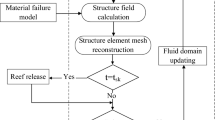Abstract
The inflation of a five-ring cone parachute with the airflow velocity of 18 m/s is studied based on the simplified arbitrary Lagrange Euler (SALE)/fluid-structure interaction (FSI) method. The numerical results of the canopy shape, stability, opening load, and drag area are obtained, and they are well consistent with the experimental data gained from wind tunnel tests. The method is then used to simulate the opening process under different velocities. It is found that the first load shock affected by the velocity often occurs at the end of the initial inflation stage. For the first time, the phenomena that the inflation distance proportion coefficient increases and the dynamic load coefficient decreases, respectively, with the increase in the velocity are revealed. The above proposed method is competent to solve the large deformation problem without empirical coefficients, and can collect more space-time details of fluid-structure-motion information when it is compared with the traditional method.
Similar content being viewed by others
Abbreviations
- ρ :
-
air density
- t :
-
time
- v :
-
velocity
- c :
-
relative velocity in the reference field
- b :
-
body force
- δ ij :
-
Kronecker coefficient
- u :
-
displacement
- X(X i ):
-
Lagrangian coordinate
- x(x i ):
-
Eulerian coordinate
- ζ(ζ i ):
-
reference grid coordinate
- n :
-
boundary normal vector
- σ :
-
stress
- τ :
-
non-aerodynamic outside force
- p :
-
pressure
- ϕ :
-
generalized variable
- F:
-
flow field
- S:
-
structure field
References
Peng, Y., Cheng, W. K., Song, X. M., and Zhang, Q. B. Summery for the research methods of parachute inflation process. Chinese Space Science and Technology, 24, 38–44 (2004)
Wang, L. R. Parachute Theory and Application (in Chinese), Space Navigation Press, Beijing, 187–229 (1997)
Stein, K. R., Benney, R. J., and Steeves, E. C. A Computational Model that Couples Aerodynamic Structural Dynamic Behavior of Parachutes During the Opening Process, NASA, ADA264115 (1993)
Yu, L. and Ming, X. Study on transient aerodynamic characteristics of parachute opening process. Acta Mechanica Sinica, 23, 627–633 (2007)
Yu, L., Shi, X. L., and Ming, X. Numerical simulation of parachute during opening process (in Chinese). Acta Aeronautica et Astronautica Sinica, 28, 52–57 (2007)
Tezduyar, T. E., Behr, M., and Liou, J. A new strategy for finite element computations involving moving boundaries and interfaces-the deforming-spatial-domain/space-time procedure: I. the concept and the preliminary numerical tests. Computer Methods in Applied Mechanics and Engineering, 94, 339–351 (1992)
Tezduyar, T. E., Behr, M., and Mittal, S. A new strategy for finite element computations involving moving boundaries and interfaces-the deforming-spatial-domain/space-time procedure: II. computation of free-surface flows, two-liquid flows, and flows with drifting cylinders. Computer Methods in Applied Mechanics and Engineering, 94, 339–351 (1992)
Stein, K., Benney, R., and Kalro, V. Parallel computation of parachute fluid-structure interactions. Proceedings of the 14th AIAA Aerodynamic Decelerator Technology Conference, San Francisco, AIAA-97-1505 (1997)
Kalro, V. and Tezduyar, T. A parallel 3D computational method for fluid-structure interactions in parachute systems. Computer Methods in Applied Mechanics and Engineering, 190, 321–332 (2000)
Stein, K., Benney, R., Kalro, V., Tezduyar, T. E., Leonard, J., and Accorsi, M. Parachute fluid-structure interactions: 3-D computation. Computer Methods in Applied Mechanics and Engineering, 190, 373–386 (2000)
Stein, K., Benney, R., and Tezduyar, T. Fluid-structure interaction of a cross parachute: numerical simulation. Computer Methods in Applied Mechanics and Engineering, 191, 673–687 (2001)
Tezduyar, T. E., Sathe, S., Pausewang, J., Schwaab, M., Christopher, J., and Crabtree, J. Fluid-structure interaction modeling of ringsail parachutes. Computational Mechanics, 43, 133–142 (2008)
Takizawa, K., Wright, S., Moorman, C., and Tezduyar, T. E. Fluid-structure interaction modeling of parachute clusters. International Journal for Numerical Methods in Fluids, 65, 286–307 (2011)
Takizawa, K., Spielman, T., Moorman, C., and Tezduyar, T. E. Fluid structure interaction modeling of spacecraft parachutes for simulation-based design. Journal of Applied Mechanics, 79, 1–9 (2012)
Yongsam, K. and Charles, S. P. 3-D parachute simulation by the immersed boundary method. Computers and Fluids, 38, 1080–1090 (2009)
Karagiozis, K., Kamakoti, R., Cirak, F., and Pantano, C. A computational study of supersonic disk-gap-band parachutes using large-eddy simulation coupled to a structural membrane. Journal of Fluids and Structures, 27, 175–192 (2011)
Winslow, A. M. Numerical solution of the quasilinear Poisson equation in a nonuniform triangle mesh. Journal of Computational Physics, 135, 128–138 (1997)
Ma, C. S., Yue, H., and Huang, S. L. A study on airbag folding patterns for improving occupant protection effectiveness. Automotive Engineering, 27, 350–353 (2005)
Cheng, H., Yu, L., and Yin, Z. W. A new method of complicated folded fabric modeling. Journal of Harbin Institute of Technology, 19, 43–47 (2012)
Author information
Authors and Affiliations
Corresponding author
Additional information
Project supported by the National Natural Science Foundation of China (No. 11172137) and the Aeronautical Science Foundation of China (No. 20122910001)
Rights and permissions
About this article
Cite this article
Cheng, H., Zhang, Xh., Yu, L. et al. Study of velocity effects on parachute inflation performance based on fluid-structure interaction method. Appl. Math. Mech.-Engl. Ed. 35, 1177–1188 (2014). https://doi.org/10.1007/s10483-014-1852-6
Received:
Revised:
Published:
Issue Date:
DOI: https://doi.org/10.1007/s10483-014-1852-6
Key words
- fluid-structure interaction (FSI)
- parachute
- inflation performance
- velocity
- empirical coefficient
- opening shock load




